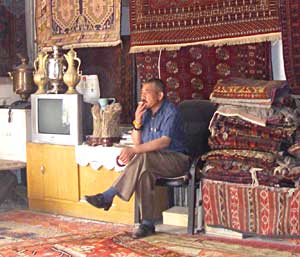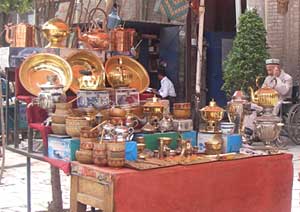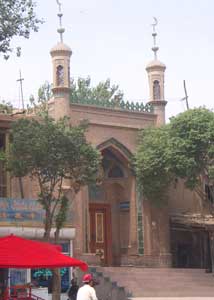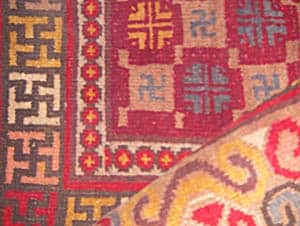Kashgar’s Famous Sunday Market for a ‘Priceless Carpet’
By Valerie Sartor

Last month cabin fever overwhelmed me. I desperately needed a break: from my polite but wily students, from my unsatisfactory yet demanding lover, and from my overpopulated and mundane Chinese city.
But going abroad took too much time, money, and planning. Suddenly, in a flash of insight, I recalled Kashgar, the Chinese Silk Road city just four hundred kilometers from the Afghanistan border.
Safer Than Going to Rome
“It’s a fabulous forgotten world,” a chubby Italian photojournalist had gushed to me over noodles. “They’re Moslems who irrigate their desert fields with the karez, an ancient underground artery system.
And the food: melons, almonds, figs: you’d think you were in Iran. The aroma of roast lamb and flatbread wafts everywhere.”
He kissed his fingers appreciatively. “The Internet has arrived but the city still lives in a Biblical era. Mosques call people to prayer. Plus Kashgar has the largest Sunday market in China.”
“Is it safe for a lone woman traveler?” I queried.
No further persuasion was necessary. I booked my flight. A few hours later I found myself strolling through the Kashgar airport where a very friendly and very charming Uighur man grinned at me, exposing two flashy gold teeth. “Safer than going to Rome, my dear,” he retorted, winking.
“Bus to town?” he asked cheerfully. I nodded, following the tourists padding behind him.

He dropped me off at the Seman Hotel, once the Russian Consulate. There, a pretty young maid in national dress led me to my room.
“Not cheap but eminently suitable,” I thought smugly, noting the ornately plastered walls, soft bed, and lace curtains. “No wonder the Russians hated to leave this joint.”
Strategic Location
And in fact, throughout history, many nations, particularly China, have fought for control of Kashgar and its environs.
Although this remote city is closer to either Moscow or New Delhi than to Beijing its location is strategic, for the city sits at the foot of the enormous Pamir Mountains. Kashgar traders and warriors staggered across them and then tackled the treacherous Taklamakan Desert, following the Silk Road highway from China into Central Asia, India, and Persia.

“This desert oasis town connected Rome and China over two thousand years ago,” I mused on the second day as I made my own desert crossing in a bumpy bus to neighboring Hotan, a city famous for rugs and jade.
The eight-hour journey dehydrated and exhausted me. “How did they do this on camels and ponies?” I grimly wondered, trying not to stare as a haggard old grannie across the aisle retched loudly into a flimsy plastic bag.
Back to Kashgar
In the Hotan bazaar, more frustration greeted me. A stern, grizzled rug dealer in a green embroidered fez advised: “Go back to Kashgar. We send our best stuff there.”
Wearily I boarded the musty old bus again, my skin itching from the searing heat and dry air. “At least I’m passing historically significant places,” I mumbled to myself, dozing on the shoulder of an accommodating and very fat Moslem farmer.
He smelled of sheep and cheap tobacco yet graciously proffered his round flatbread and roast mutton chunks with me. I extended my warm cola in return.
Indeed, for centuries the Chinese controlled Kashgar and its environs, only reluctantly ceding it to Tibet during the Tang Dynasty. Later, between the tenth and twelfth centuries, the Turks arrived, causing Islam to topple Buddhism as the dominant religion.

Strategic Location
These fierce Turkish nomads understood the city’s strategic location for trade. Although the Mongolian leader Tamerlane sacked Kashgar in the 1300’s Islam and the Turkish people remained for good.
Then, in the 1800s this mesmerizing Muslim city became important again. Russians, Chinese, and British struggled for control of Central Asia; they all wanted Kashgar.
Again the Chinese won out – fortunately for tourists like me who frankly adore sleeping in the elegant but long-defunct Russian consulate.
Hitting it Off
Back in the hotel I quickly met up with a wiry 35-year-old, bilingual Uighur guide called Omar. We hit it off as we biked leisurely around his city, exploring streets and alleyways.
My senses quickened; Kashgar bustled around me in a very un-Chinese fashion. Musicians played drums with a sensual, staccato beat, advertising new shops. Eager vendors hawked blood-red pomegranate juice and glistening melon slices, thrusting them at me as I rode past.
Sultry Uighur Women

Stately, sultry women strolled by in sequined gowns and colorful headscarves, their kohl-lined eyes languid but bright. Large-eyed, bearded businessmen in pale caftans crouched in shadowed doorways, scanning the alleys for shoppers.
Few people spoke Chinese, for over ninety percent of the city’s 300,000 residents are Turkic; Uighurs, Tajiks or Kazakhs.
I marveled as lean Turkish artisans worked on the street banging out copper pots and steel knives but soon they bored me. Insistently I tugged at Omar’s ragged T-shirt, and demanded, “Rugs: please take me to see the quality carpet.”
Patiently he led me around to his friends’ shops. Finally, the legendary Hotan carpets were at my fingertips, as well as kilims carried in by dusty, dark-eyed traders from Iran, Afghanistan, and Turkmenistan. We sat on piles of precious carpet, haggling in slow motion, quietly, like poker players.
A Tip or a Fling

Bargaining here is not only acceptable but comme il faut. Finally, after hours of negotiating and drinking endless bowls of murky tea, I lugged out into the bright sunshine my prize: a beautiful Afghan camel’s hair carpet.
“You really did well for a foreign lady,” commented Omar as we rode back to the hotel. “And you certainly do not look your age.” He glanced at my sweaty bosom. Pleased and somewhat flattered by his attention I wondered if he was seeking either a tip or a fling.
“Hah,” I smirked internally, “If he were ten years older he’d get both, for these swarthy Uighur men are undeniably sexy.”
But outwardly I demurely replied, “Certainly, a return trip is necessary to look around for more treasures in your extraordinary city.”
A Family Heirloom
A few hours later Omar politely accompanied me to the airport, pressed my hand warmly, and bid me a safe trip home.
And me? I clutched my rug tightly and chuckled in glee. My trip had provided a real adventure, mild flirtation, new friends, and a very glamorous home furnishing. Undoubtedly this carpet would last longer than my lifetime. It would be reverently passed down as a family heirloom.
“Our eccentric Auntie V brought that home,” my sweet nieces would proudly gloat. “She went to the ends of the earth to get it, too.”

Valerie Sartor is a sociolinguist who studies the politics of language among multilingual non-mainstream youth. Her dissertation (2014) focused upon Russian-born Buriat Mongolian youth who migrated to Chinese Inner Mongolia for educational purposes. From 2014-2015, Valerie served as a Fulbright Scholar in Irkutsk in the Russian Federation.
- Saudi Arabia Might Be Your Next Getaway Spot - April 23, 2024
- Mongolia, the Land of Eternal Blue Sky - April 20, 2024
- These 9 U.S. National Parks Require Reservations in 2024 - April 17, 2024

